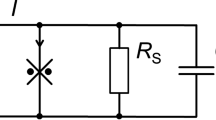Abstract
High-power thyristor switching from the blocking to conducting state via an overvoltage pulse with nanosecond rise time is studied. Low-frequency tablet thyristors with an operating voltage of 2 kV are used in the experiments. An external pulse providing a voltage rise rate from 0.5 to 6 kV/ns was applied to the thyristors main electrodes. Under these conditions, the time of thyristor switching to the conducting state is 200–400 ps. Empirical relations between the main switching characteristics, i.e., the turn-on voltage, pulse rise time before switching, and time of thyristor switching to the conducting state, are obtained. Numerical simulation shows that the ionization of deep technological defects should be taken into account to explain the results obtained.
Similar content being viewed by others
References
Yu. V. Aristov, V. B. Voronkov, I. V. Grekhov, A. K. Kozlov, S. V. Korotkov, and A. G. Lyublinskii, Instrum. Exp. Tech. 50, 224 (2007).
S. V. Korotkov, Yu. V. Aristov, V. B. Voronkov, A. L. Zhmodikov, D. A. Korotkov, and A. G. Lyublinskii, Instrum. Exp. Tech. 52, 695 (2009).
I. V. Grekhov, S. V. Korotkov, and P. V. Rodin, IEEE Trans. Plasma Sci. 36, 378 (2008).
I. V. Grekhov, IEEE Trans. Plasma Sci. 38, 1118 (2010).
V. M. Tuchkevich and I. V. Grekhov, New Principles of Switching High Powers by Semiconductor Devices (Nauka, Leningrad, 1988) [in Russian].
A. I. Gusev, S. K. Lyubutin, S. N. Rukin, and S. N. Tsyranov, Izv. Vyssh. Uchebn. Zaved., Fiz., No. 12/2, 152 (2014).
A. I. Gusev, S. K. Lyubutin, S. N. Rukin, and S. N. Tsyranov, Instrum. Exp. Tech. 58, 376 (2015).
http://www.proton-electrotex.com
S. K. Lyubutin, S. N. Rukin, B. G. Slovikovskii, and S. N. Tsyranov, Semiconductors 46, 519 (2012).
A. I. Gusev, S. K. Lyubutin, S. N. Rukin, B. G. Slovikovskii, and S. N. Tsyranov, Semiconductors 48, 1067 (2014).
P. Rodin, A. Rodina, and I. Grekhov, J. Appl. Phys. 98, 094506 (2005).
E. V. Astrova, V. B. Voronkov, V. A. Kozlov, and A. A. Lebedev, Semicond. Sci. Technol. 13, 488 (1998).
G. I. Skanavi, The Physics of Dielectrics (The Region of Strong Fields) (Fizmatlit, Moscow, 1958), Chap. 5, p. 141 [in Russian].
A. Minarsky and P. Rodin, J. Appl. Phys. 113, 144512 (2013).
A. F. Kardo-Sysoev, in Ultra-Wideband Radar Technology, Ed. by J. D. Taylor (CRC Press, Boca Raton, London, New York, Washington, 2001).
A. F. Kardo-Sysoev and M. V. Popova, Semiconductors 30, 431 (1996).
P. B. Rodin, A. M. Minarskii, and I. V. Grekhov, Tech. Phys. Lett. 38, 535 (2012).
Author information
Authors and Affiliations
Corresponding author
Additional information
Original Russian Text © A.I. Gusev, S.K. Lyubutin, S.N. Rukin, S.N. Tsyranov, 2016, published in Fizika i Tekhnika Poluprovodnikov, 2016, Vol. 50, No. 3, pp. 398–407.
Rights and permissions
About this article
Cite this article
Gusev, A.I., Lyubutin, S.K., Rukin, S.N. et al. High-Power Thyristor Switching via an Overvoltage Pulse with Nanosecond Rise Time. Semiconductors 50, 394–403 (2016). https://doi.org/10.1134/S1063782616030106
Received:
Accepted:
Published:
Issue Date:
DOI: https://doi.org/10.1134/S1063782616030106



